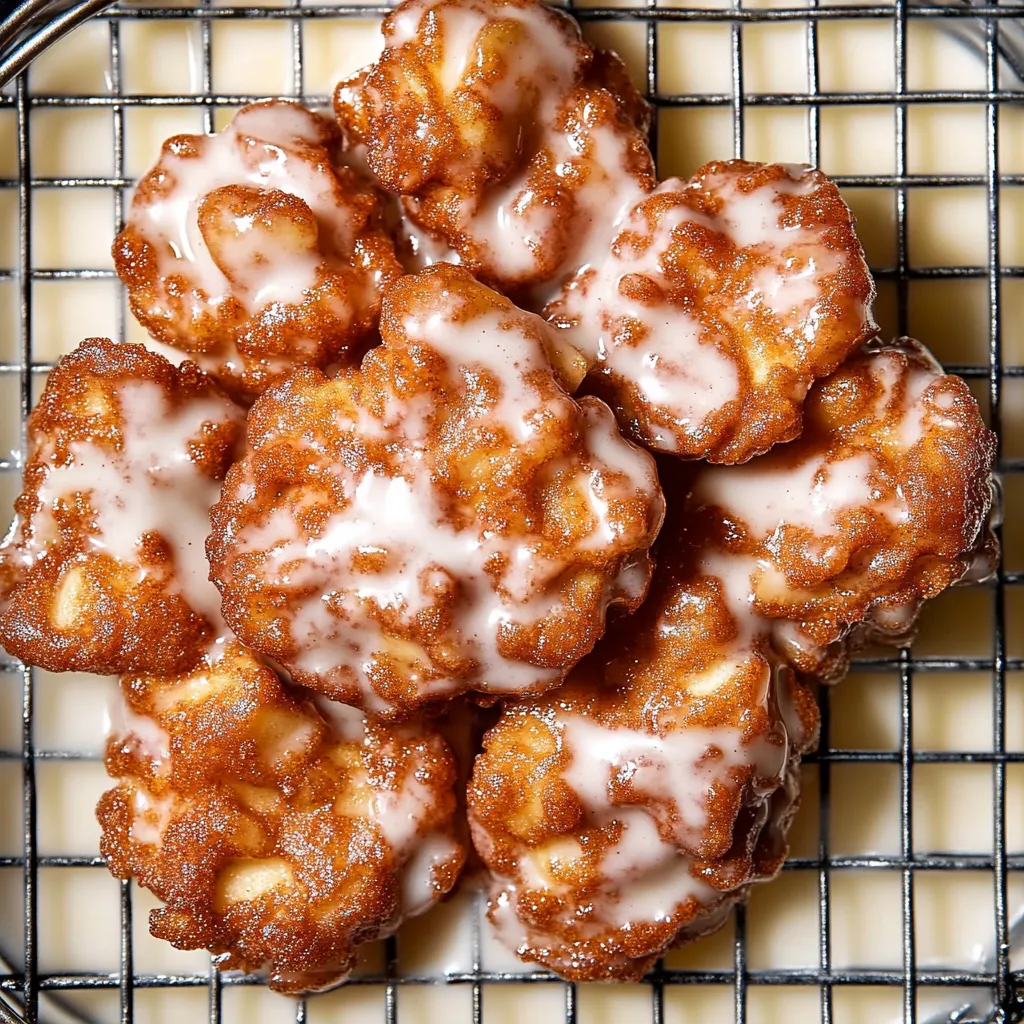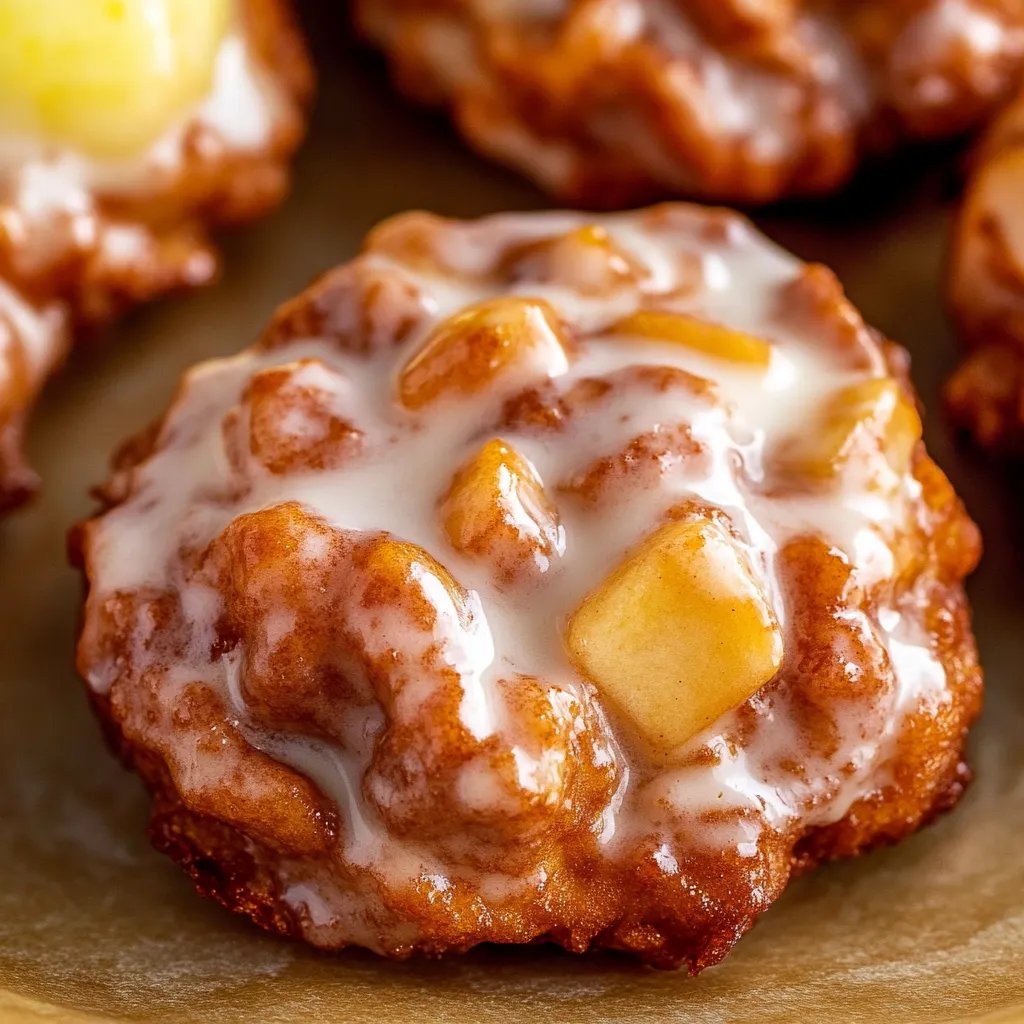 Pin it
Pin it
These golden-brown apple fritters capture autumn's essence in every bite—tender chunks of apple nestled in a warmly spiced dough that fries to perfection with irresistibly crisp edges and a soft, pillowy interior. The crowning glory comes from a generous coating of cinnamon-vanilla glaze that seeps into every nook and cranny, creating a sweet shellac that keeps these treats moist while adding just the right amount of sweetness. Unlike many intimidating deep-fried recipes, these fritters come together with surprising ease, requiring just basic pantry ingredients and about 30 minutes of active time. The result is a bakery-worthy treat that fills your kitchen with an intoxicating aroma of apples, cinnamon, and vanilla that simply screams "fall has arrived."
The first time I made these fritters, I was intimidated by the idea of deep frying at home, but I was craving that unmistakable apple fritter experience that no baked version could replicate. My family gathered in the kitchen, drawn by the irresistible aroma, and the first batch disappeared before they even fully cooled. My daughter, who typically gravitates toward chocolate desserts, declared them "even better than donuts" and now requests them every fall when apple season arrives. What began as a weekend experiment has become our cherished autumn tradition—a simple yet spectacular treat that marks the changing of the seasons in the most delicious way possible.
Essential Ingredients
- Fresh Apples: Form the heart and soul of these fritters, providing bursts of juicy sweetness and gentle texture throughout each bite. Fuji apples offer the perfect balance of sweetness and structure, maintaining their shape during frying rather than dissolving into applesauce. Their natural sweetness complements the warming spices while their firm texture provides delightful contrast to the soft dough.
- Ground Cinnamon: Provides the quintessential fall flavor that transforms these fritters from good to extraordinary. Its warm, woody notes enhance the natural sweetness of the apples while creating that instantly recognizable aroma that makes mouths water. Quality cinnamon makes a noticeable difference in the final flavor profile.
- All-Purpose Flour: Creates the structure that holds everything together while developing a tender crumb. The protein content in all-purpose flour provides just enough gluten development for a cohesive dough that maintains its integrity during frying without becoming tough or chewy.
- Whole Milk: Contributes richness and moisture that results in a tender interior. The fat content in whole milk creates a more flavorful dough than would be possible with lower-fat alternatives, while the liquid activates the baking powder and helps develop the perfect consistency.
- Unsalted Butter: Adds richness and depth that elevates these fritters beyond ordinary fried dough. The milk solids in butter contribute flavor complexity while the fat creates tenderness in the final texture. Using unsalted butter allows precise control over the overall saltiness.
- Confectioners' Sugar: Forms the base of the glaze that transforms these fritters from good to irresistible. Its fine texture dissolves completely, creating a smooth, satiny finish without any grittiness. The slight cornstarch content helps the glaze set properly, giving that characteristic shellacked appearance and satisfying mouthfeel.
Step-by-Step Cooking Instructions
- Prepare your apples for optimal flavor distribution -
- Core and dice 2 medium apples (approximately 2 cups) into ¼-inch pieces of uniform size. Toss them immediately with 1 tablespoon fresh lemon juice in a medium bowl, ensuring each piece is lightly coated. This crucial step prevents browning while adding a subtle brightness that balances the sweetness. The small, consistent size ensures that every bite contains apple and that they'll cook evenly during the brief frying time. Set aside while preparing the batter.
- Create your perfectly spiced batter -
- In a large mixing bowl, whisk together 2 cups all-purpose flour, ⅓ cup granulated sugar, 1 tablespoon baking powder, ½ teaspoon salt, 1 teaspoon ground cinnamon, and ¼ teaspoon ground nutmeg until thoroughly combined. Using a spatula, create a well in the center of the dry ingredients. Pour in ¾ cup whole milk, 1 lightly beaten large egg, 2 tablespoons melted unsalted butter (cooled slightly), and 1 teaspoon vanilla extract. Stir until just combined—the batter will be thick and somewhat lumpy, which is exactly what you want. Overmixing develops gluten that would make the fritters tough rather than tender.
- Incorporate your apple pieces -
- Gently fold the diced apples into the batter using a spatula or wooden spoon, making sure they're evenly distributed throughout. The batter will seem overwhelmed with apples—this is correct and creates the signature apple-studded texture of authentic fritters. The dough will puff and expand during frying, surrounding the apple pieces perfectly. Allow the batter to rest for 5 minutes while you prepare for frying.
- Heat your oil for optimal frying -
- Pour 3-4 cups of canola oil into a large, heavy-bottomed pot or Dutch oven, creating a depth of about 2 inches. Heat over medium-high heat until the oil reaches 375°F on a candy or deep-fry thermometer. If you don't have a thermometer, test the oil by dropping a small amount of batter into it—the batter should sizzle immediately and rise to the surface surrounded by bubbles. Maintaining the correct temperature is critical—too cool and the fritters absorb excess oil; too hot and they brown before cooking through.
- Form and fry your fritters -
- Spray a ¼-cup measuring cup with non-stick cooking spray and scoop the batter, filling it completely. Transfer the batter to a metal spatula that has also been lightly sprayed with cooking spray, and gently flatten into a disc about ½-inch thick. Carefully lower the spatula into the hot oil at a slight angle, allowing the fritter to slide off. Cook no more than 3-4 fritters at a time to prevent crowding and oil temperature drops. Fry for 2 minutes on the first side until golden brown, then gently flip using a slotted spoon or spider and fry for an additional 2 minutes until both sides are deep golden brown.
- Drain and cool properly -
- Using a slotted spoon or spider, carefully remove the fritters from the oil, allowing excess oil to drip back into the pot. Transfer to a paper towel-lined baking sheet or plate to absorb excess oil. Repeat with remaining batter, allowing the oil to return to 375°F between batches. Let the fritters cool for at least 10 minutes before glazing—this cooling period allows them to set up properly and prevents the glaze from simply melting off.
- Create and apply your cinnamon glaze -
- While the fritters cool, whisk together 2 cups confectioners' sugar, ¼ teaspoon ground cinnamon, ¼ teaspoon vanilla extract, and 3-4 tablespoons whole milk in a medium bowl until smooth and pourable but still thick enough to coat the back of a spoon. The glaze should be opaque but flow easily. Dip the top of each cooled fritter into the glaze, allowing excess to drip back into the bowl, then place on a wire rack set over parchment paper to catch drips. For an extra decadent treat, double-dip by allowing the first layer to set for 5 minutes before applying a second coat.
 Pin it
Pin it
The History of Apple Fritters
Apple fritters have a rich heritage spanning cultures and centuries, evolving from simple fried dough with fruit to the beloved treat we recognize today. Their origins trace back to medieval Europe, where fritters became a practical way to preserve fruits and create something special from basic ingredients.
In America, fritters became particularly popular during colonial times when apples were abundant and sugar was precious. The simple combination of apples, flour, and minimal sweetener created a satisfying treat that made the most of available resources. What began as a pragmatic recipe gradually evolved into a cherished tradition.
I became fascinated with fritter history after finding my grandmother's handwritten recipe card, dated 1943, that featured apple fritters as a "sugar-saving dessert" during wartime rationing. Her version used significantly less sugar than modern recipes, relying instead on the natural sweetness of apples and a thin glaze rather than the sweeter versions we enjoy today.
What's remarkable is how little the fundamental technique has changed over generations. The basic approach—folding fresh fruit into a simple batter and frying until golden—remains essentially unchanged, testifying to the enduring appeal of this straightforward but delicious concept.
The Art of Perfect Frying
Successfully frying apple fritters relies on understanding a few key principles that make the difference between heavy, greasy disappointments and light, crisp perfection. Temperature control stands as the most critical factor—maintain 375°F throughout the cooking process for that ideal balance of exterior crispness and interior doneness.
The thickness of your fritters significantly impacts their success. Too thick, and they may remain doughy in the center while the exterior burns; too thin, and they become all crunch without the tender interior that makes fritters so satisfying. The ½-inch thickness recommended in this recipe creates the perfect balance.
My most valuable frying insight came after numerous batches: allowing adequate space between fritters is non-negotiable. Crowding the pot causes the oil temperature to drop dramatically, resulting in oil-soaked fritters rather than crisp ones. The patience required to fry in smaller batches pays dividends in the final quality.
During a cooking class I took years ago, the chef shared a professional trick I've used ever since—listening to your fritters. The vigorous bubbling when first added to oil should gradually subside as they cook. When the bubbling becomes significantly quieter, it's usually time to flip them. This auditory cue has proven more reliable than strictly timing each batch.
I discovered through trial and error that the cooling period between frying and glazing is non-negotiable. My first attempt involved glazing hot fritters, resulting in a thin, virtually invisible coating that soaked in completely. When I allowed proper cooling time, the glaze set beautifully on the surface while still partially penetrating for that perfect texture contrast that defines a great fritter.
The most illuminating moment in my fritter journey came when I accidentally allowed the batter to rest for 15 minutes before frying. This happy mistake resulted in noticeably more tender fritters as the flour had time to hydrate fully and the sugar to dissolve completely. Now I intentionally build in this brief resting period, which also gives me time to prepare the glazing station and clean up the batter-making mess.
These apple fritters represent what I love most about home cooking—how simple techniques and humble ingredients can create something truly special. There's a particular joy in transforming everyday apples into a treat that feels celebratory, in mastering a technique that might initially seem intimidating. In our household, the appearance of these fritters has become a tangible marker of fall's arrival—a warm, sweet tradition that connects us to the season and to each other through shared delight in something made with care and enjoyed together.
Frequently Asked Questions
- → What kind of apples work best for apple fritters?
- Fuji apples are recommended for this recipe, but you can also use Granny Smith, Honeycrisp, or Pink Lady apples. Firm apples that hold their shape when cooked work best.
- → Can I make apple fritters ahead of time?
- Yes! You can make them a day ahead and store at room temperature or up to 4 days in the refrigerator. For best taste, reheat in a 300°F oven for 8-10 minutes.
- → How do I know when the oil is hot enough?
- Use a candy thermometer to ensure the oil reaches 375°F. If you don't have one, test by dropping a small amount of batter in - it should sizzle immediately and float to the top.
- → Can I freeze apple fritters?
- Yes, freeze unglazed fritters in an airtight container for up to 2 months. Thaw overnight in the refrigerator, then reheat in a 300°F oven and glaze before serving.
- → Why did my fritters fall apart while frying?
- This usually happens if the oil isn't hot enough or if the batter is too thin. Make sure your oil is at 375°F and your batter is thick enough to hold the apple pieces together.
- → Can I bake these instead of frying?
- While frying gives the best texture, you can bake them at 375°F for about 15-18 minutes on a parchment-lined baking sheet. The texture will be more cake-like and less crispy.
